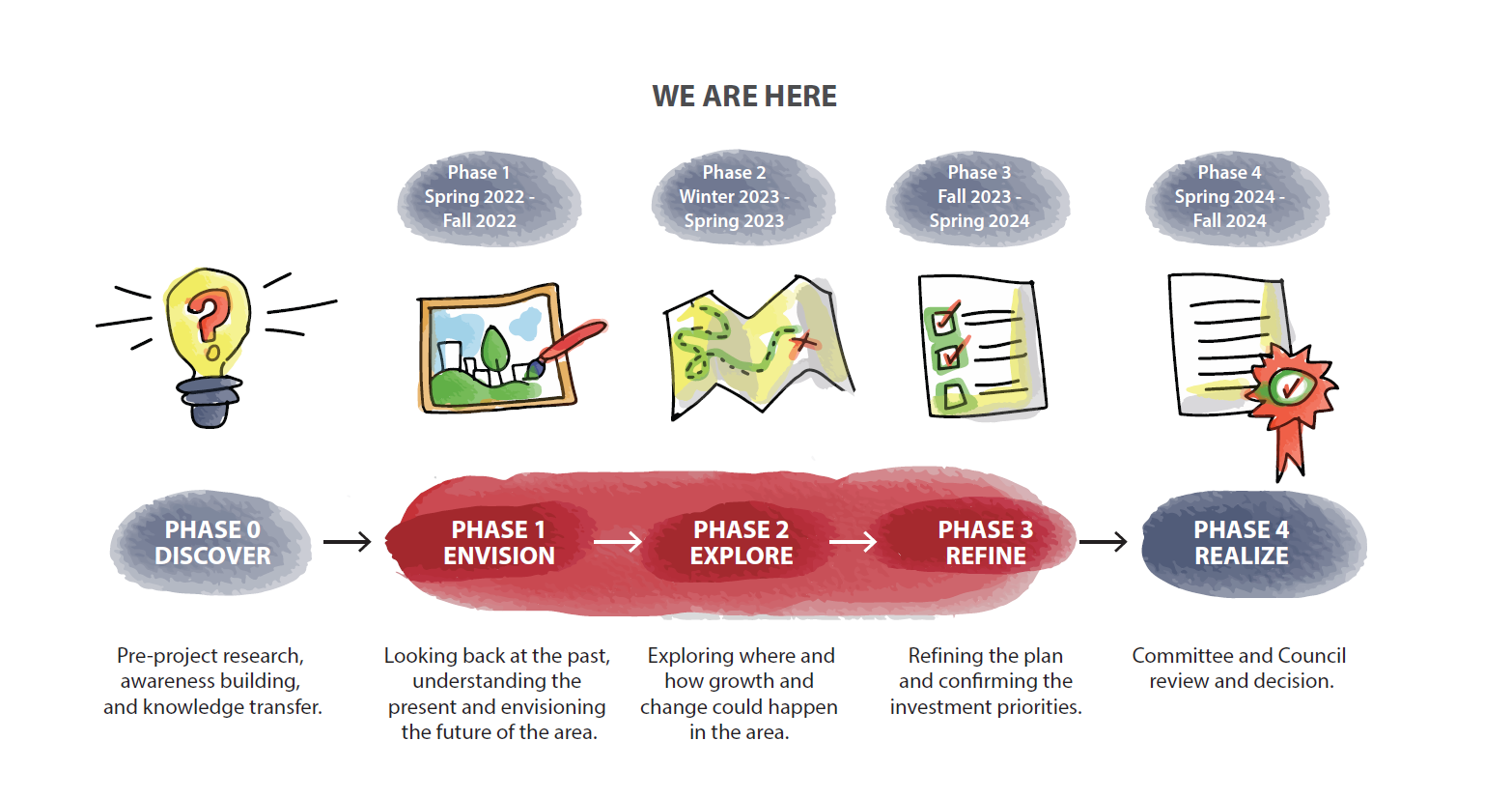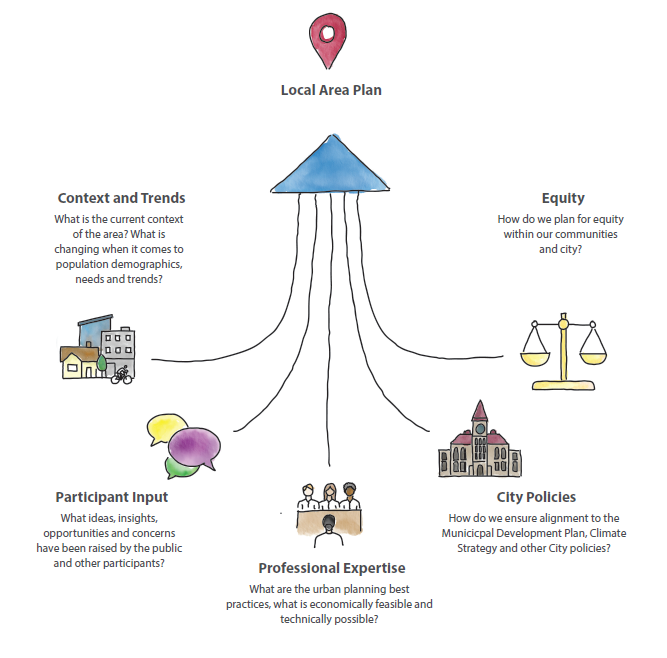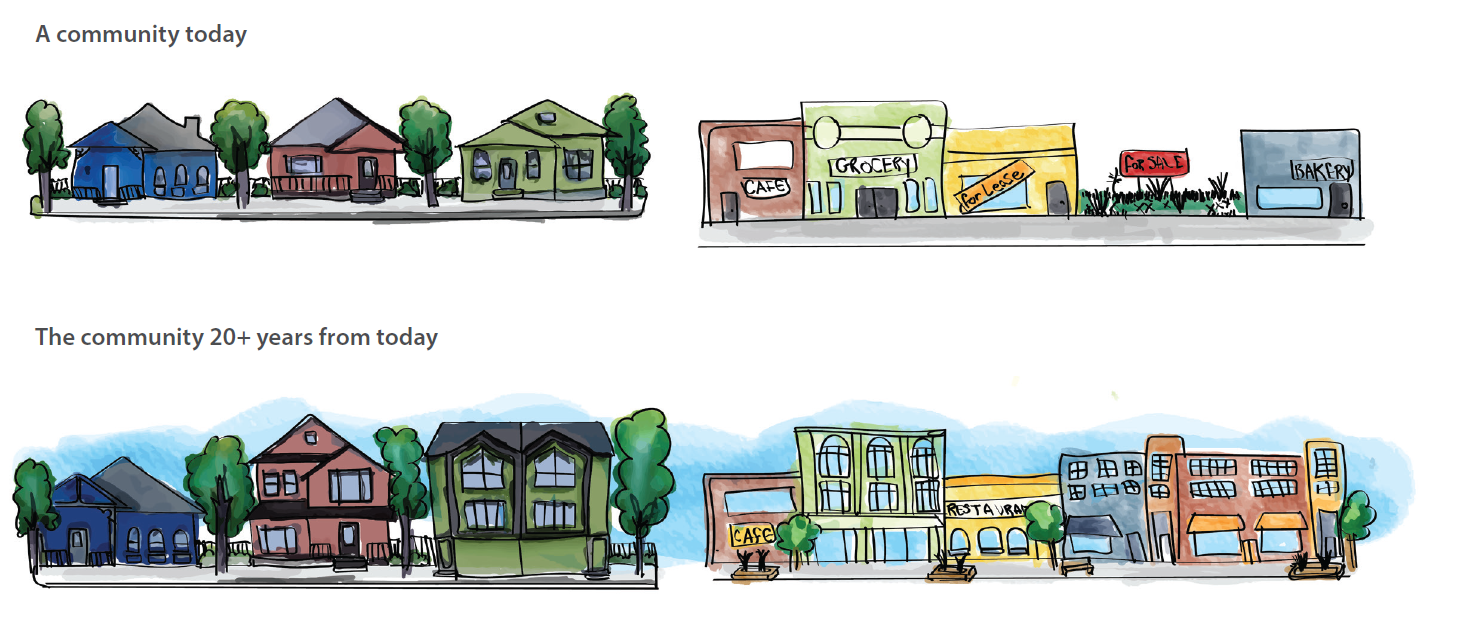Phase 2: Explore is now CLOSED
Phase 2 engagement is now closed, click below to return to the main Riley Communities Local Area Plan page.
Community Redevelopment. It's complex. Let's chat.
Welcome to the second phase of engagement! We are working together to create the local area plan for the Riley Communities of Hillhurst, Hounsfield Heights - Briar Hill, Sunnyside and West Hillhurst and need your feedback.
Engagement for Phase 2 - EXPLORE was open from January 17 - February 12, 2023 and included multiple ways to share feedback:
- Review and answer the questions on the Feedback Form below.
- Attend an in-person or virtual public Q&A session (more details in the Get Involved section).
- Check your mailbox for an Engagement Booklet, or pick one up at My Idea Station.
Overview
Planning Together for the Next 30 Years
What is a Local Area Plan?
A local area plan sets the vision for the evolution of the area over the next 30 years. It provides direction on future development and investment that residents, landowners, builders / developers, City Planners and Council can commonly refer to when new development and investment ideas are proposed.
Why Do We Need a Local Area Plan?
The city, communities and streets we call home have changed, are changing, and will continue to change. People renovate, rebuild, enlarge and modify spaces around them all the time. We need to make sure there’s room for people looking to make changes and direction to help guide decisions. We also need to provide guidelines for investment when change is proposed, and certainty for residents to know how their community may change in the future.
In Phase 1 - ENVISION, we asked you to help us look back at the past, understand the present and envision the future. The feedback provided helped us draft a Vision and Core Values for the Riley Communities that will help guide decisions about the evolution of the area over the next 30 years.
We are currently in Phase 2 – EXPLORE, and we want to hear your thoughts on the draft Vision and Core Values. We’re also going to start looking at where and how growth and change could happen in the area.

A local area plan is influenced by several different sources including the community context, participant feedback, professional expertise, City policies and equity considerations. A ‘What We Heard Report’ and a ‘What We Did Report’ compiling all participant feedback, key themes and actions taken will be shared at the end of each engagement phase.

Why New Growth
Let’s Chat About Why We Need to Accommodate New Growth
Our communities, and the people living in them, have changed since they were first built and will continue to change. It’s important to have a plan in place to guide how our communities will evolve over the next 30 years, and there are a few key considerations to keep in mind.
While Calgary’s population has been growing approximately 1.8 per cent every year since 1985, the peak population within 86 per cent of Calgary’s established communities has declined. Population stability within established communities is essential to support local schools, businesses, services and infrastructure. It is proven that greater housing choice and diversity support increased population and stabilization within Calgary’s established communities.
The composition of Calgary’s population is changing. Peoples’ housing needs and preferences are changing as well (e.g., smaller households, a desire to age in place, affordability, etc.). There was an average of 3.5 people per dwelling citywide in 1969, and today it is only 2.7. With no new dwellings and growth, the result is a 23 per cent population decline in established areas. These demographic and socioeconomic changes directly support a need for greater variety of housing choices in established areas.
The Municipal Development Plan (or MDP, our city’s 60-year plan that guides growth and change) seeks to balance growth between developed and established areas of the city. It has a goal to achieve 50 per cent of overall growth from 2006 to 2066 within our established neighbourhoods. This means we need to allow more homes of different types in our established communities and each community can accommodate evolving forms of growth and change.
Communities change and evolve over time. We’re creating a local area plan to help ensure change happens in the right ways in the Riley Communities.

Engagement BookletEngagement booklets have been created for each phase of engagement as a way for you to learn more about what's being discussed and provide your feedback. The Riley communities will receive an engagement booklet for Phase 2 in their mailboxes starting January 17, 2023. Complete the feedback form on the back page of the engagement booklet and drop it in the mail (pre-paid postage is included) by February 12, 2023. You can also:
|
Feedback Form
The Phase 2 opportunity for feedback is now closed! Thank you to everyone who participated and offered feedback during the second phase of engagement for the Riley Communities Local Area Plan.
Below you can see the topics we received feedback in Phase 2 EXPLORE of the Riley Communities Local Area Plan.
- Topic 1: Draft Vision & Core Values
- Topic 2: Potential Focus Areas for Medium-Large Scale Growth
- Topic 3: Small-Scale Growth
There was also an Additional Feedback tab where participants could review and provide feedback on the initial draft chapters of the local area plan.
Topic 1
Topic 1: Draft Vision & Core Values
Community change and evolution are gradual, but many small changes can have a big impact over the long term. Having a local area plan in place will ensure that future developments contribute to the big picture outcomes that we’re planning for.
The draft Vision and Core Values in the local area plan summarize the big ideas, hopes and priorities for the area’s evolution and are used as a foundation for discussions as the local area plan is created.
Please review the draft Vision and Core Values below to answer the first survey question.
Draft Vision
Situated near the Bow River and the Downtown Core, the Riley Communities of Hillhurst, Hounsfield Heights - Briar Hill, Sunnyside and West Hillhurst will continue to grow and build upon the unique assets and histories of the area. The variety of housing, amenities, attractions and mobility options will form a foundation to further the area as one of the most vibrant parts of the city. The area will see continued improvements and investments that enhance the diverse experiences and quality of life of those who live and visit.
Draft Core Values

Housing Choice
Expand the range of housing options in the Riley Communities to meet the evolving needs, life stages and household compositions of Calgarians. Ensure that as new housing is developed, it suits the evolving context of each of Riley’s individual communities.

Moving to and through the Riley Communities
Support and provide increased ways to move to and through the Riley Communities that emphasize safe, accessible and efficient movement. Prioritize walking, transit and active modes as key ways to move around the Riley Communities and to surrounding destinations by building upon existing infrastructure such as the Red Line LRT system, regional pathway system and pedestrian network.

Parks, Recreation and Open Space
Expand and enhance the inventory of parks, recreation facilities, natural areas and public spaces throughout the Riley Communities, including the McHugh Bluff and spaces along the Bow River. Focus on providing a range of parks and recreation spaces near all living in the Riley Communities.

Climate Resilience
Improve long-term climate resiliency and reduce vulnerability to localized climate-related hazards such as flooding along the Bow River, heavy rainfall and extreme heat. Achieve this through supporting low-carbon lifestyles and area-specific improvements that mitigate the impacts of severe weather events and expand the urban tree canopy.

Aligning Improvements to Growth
Enable continued mixed-use development along Main Streets and corridors such as 10th Street N.W., 14th Street N.W., Kensington Road and 19th Street N.W. as well as transit-oriented development around the Sunnyside and Lions Park LRT stations. Facilitate the creation of public amenities that support growth and change and further enhance the sense of place within these communities.

Safe and Accessible Communities
Promote community safety and accessibility for all. Ensure that safety and accessibility are key considerations in public realm improvements, new building design, and in considering improved transportation options.
Topic 2
Topic 2: Moderate-to Large-Scale Growth

Moderate-to large-scale growth represents homes and businesses that are four storeys or more in height. These can be completely residential or mixed-use with both residences and businesses.
New moderate-to large-scale buildings for homes and businesses give more people the option of living near local amenities, shops, and restaurants. Since more people bring more businesses to an area, it also provides all residents with increased access to a greater variety of amenities and services nearby.
There are areas in the city where this type of development is already directed to go. Focus areas for growth are outlined in Calgary’s Municipal Development Plan (MDP).
These growth focus areas include:
- Main Streets - Areas of higher density, activity and a variety of uses along specified streets or routes. Examples in the Riley Communities are Kensington Road N.W., 10th Street N.W. and 14th Street N.W.
- Transit Station Areas - Locations around Light Rail Transit (LRT) stations and bus stops with frequent transit such as the MAX line where mixed-use and higher-density development should occur. Lions Park and Sunnyside LRT stations are currently the Transit Station Areas in the Riley Plan area.
- Activity Centres – Concentrated areas of growth with high activity and a variety of uses. Examples in the Riley Communities include the area surrounding North Hill Mall and the former Grace Hospital Site.
In addition to the Existing Focus Areas for Growth, City planners, the Riley Communities Working Group and local community associations have reviewed public feedback from the first engagement phase on what exists today and discussed areas where there could be potential for additional growth in the future.
The map below outlines both Existing Focus Areas for Growth (areas with existing land use / zoning of four storeys or more, or areas where Council-approved policy supports more growth —shown in orange on the map) as well as Additional Potential Focus Areas for Growth where we think this type of development could potentially be appropriate (up for discussion; based on engagement so far and key considerations — shown in pink on the map).
Focus areas for growth are areas where buildings such as residential apartments, buildings with shops on the bottom floor and residential above (mixed-use), or commercial and professional office buildings would fit best.
- The pink areas are additional potential focus areas for growth to discuss and consider. Based on feedback received so far, these are areas where people think it might make sense for new buildings that are four storeys (or potentially higher) to go.
- The orange areas are existing focus areas for growth. These areas are already zoned / have land use that allows for four storeys or more or where Council-approved policy directs for four storeys (or potentially higher) in the future.
Topic 3
Topic 3: Small-Scale Growth - Three Storeys or Less
A small-scale home is any structure that is three storeys or less containing one or more units with individual exterior entrances. Small-scale homes include single-detached homes, semi-detached homes, duplexes, rowhouses, triplexes, fourplexes, and other forms that share those same characteristics. Basement or backyard suites could be included in all small-scale homes except triplexes and fourplexes.
Today, a single-detached home can be built up to three storeys in any residential area without the need to change the land use / zoning. Rather than only having the option to rebuild a single-detached home, which is and always will be a choice, people may want, need or prefer something different.
Having a variety of Small-Scale Homes has many benefits for a community:
- Population stabilization and growth: Communities that have more housing choices have seen their populations stabilize or gradually increase which supports local businesses, schools, recreation facilities and community reinvestment.
- Housing choice: One size doesn’t fit all. Having a variety of homes to choose from attracts people of different ages and family compositions, creating vibrant communities.
- Supporting changing life needs: Having more housing options provides the opportunity to live and remain in the same community close to friends, family and the things we know and enjoy, as our housing needs change over our lifetime.

Examples of Small-Scale Homes
Different Types of Small-Scale Homes
(based on the Land Use Bylaw Rules)
- Contain one primary residence and may include a backyard or basement suite.
- Can be different scales including one storey (bungalow) two or three storeys.
- The general lot coverage is 45 per cent and the maximum height is 10 metres.

(based on the Land Use Bylaw Rules)
- Contain two primary residences in one building and may include a basement suite or backyard suite for each primary residence.
- Residences in semi-detached dwellings are separated from each other side to side, and duplexes are separated above and below.Can be different scales including one storey (bungalow) two or three storeys.
- The general lot coverage is 45 per cent and the maximum height is 10 metres. This makes the massing generally similar to a single-detached home.
(based on the Land Use Bylaw Rules)
- Contain three or more residences on a property and may include a basement suite or backyard suite for each primary residence.
- Typically have up to 60 per cent lot coverage and up to three storeys in height (11 metres).

(based on the Land Use Bylaw Rules)
- Contain three or more primary residences (suites are not permitted).
- Residences not required to have front entrance facing the street.
- Typically have up to 60 per cent lot coverage and can be up to three storeys in height (11 metres).
- Residences are separated from each other side to side and / or top to bottom.

Additional Feedback
Additional Feedback: Draft Chapters
The initial draft chapters of the Riley Local Area Plan are available for review. Please click on the links to review and give your feedback in the question below.
- Refined Draft Chapter 1 - Riley Communities Local Area Plan: Information about the history of the area, the area as it exists today, and the future vision and core values to help guide growth and change are included in draft Chapter 1.
- Draft Chapter 2 - Riley Communities Local Area Plan: An initial draft of Chapter 2 has been created for review.
Chapter 1 draft content was created and refined through engagement in Phase 1: ENVISION. Initial Chapter 2 draft content was created based on engagement in Phase 1: ENVISION and will be further refined based on feedback provided through Phase 2: EXPLORE.
A refined version of Chapter 2 will be shared in the next phase and will be further refined based on input collected in Phase 3: REFINE.







